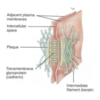Cells & Tissues Flashcards
What body system is the CNS part of?
Nervous
What body system are appendicular muscles part of?
Muscular
What is the primary function of the scrotum in the male reproductivity system?
Reproduction and thermal control tests
What is the primary function of lymphatic fluid in the lymphatic system?
- Transport lipids (fats and fatty acids) from the gut
- Fluid from tissues
What is the primary function of the axial muscles in the muscular system?
Provides support and positioning of the axial skeleton
What body system is the hypothalamus/pituitary gland part of?
Endocrine
What is the primary function of the vagina and external genitalia in the female reproductivity system?
- Lubrication
- Sperm reception
- Birth canal
What body system are tendons and aponeuroses part of?
Muscular
What are the organ structures in the lymphatic system?
- Lymphatic vessels
- Lymphatic fluid
- B cells and T cells
- Lymph nodes including tonsils
- Spleen
- Thymus
What body system is the dermis part of?
Integumentary
What is the primary function of the epidermis in the integumentary system?
- Protects deeper tissues and covers surfaces
- Vitamin D production
What is the primary function of the veins in the CV system?
Conduits return blood from capillaries to heart
What is the primary function of the small intestine in the digestive system?
- Digestive enzymes
- Buffers and hormones
- Absorbs nutrients
What is the primary function of the bronchi in the respiratory system?
Conducts air between trachea and lungs
What body system is the uterus part of?
Reproductive - female
What is the primary function of the epididymis in the male reproductivity system?
Sperm maturation
What does EPO stand for?
Erythropoietin
What is the primary function of the blood in the CV system?
- Transport of oxygen and carbon dioxide
- Transports nutrients and hormones
- Removes waste
- Temperature regulation
- Defence against illness - immune cells
- Acid-base balance - -HCO3
What is the primary function of the skeletal muscles in the muscular system?
- Provide skeletal movement
- Control entrances and exits to the digestive, respiratory and urinary systems
- Produces heat
- Supports the skeleton
- Protects soft tissue
What features come under pulmonary circulation?
- Lymph nodes
- Lymphatic capillaries
- Pulmonary blood capillaries
What are the major functions of the epithelial tissues?
- Protection
- Filtration
- Secretion
- Absorption
- Excretion
What is the primary function of the urethra in the male reproductivity system?
Sperm to exterior
What is the primary function of the lungs in the respiratory system?
- Air movement
- Gas exchange of oxygen and carbon dioxide in alveoli
- Acid-base control
What body system is the oesophagus part of?
Digestive

















